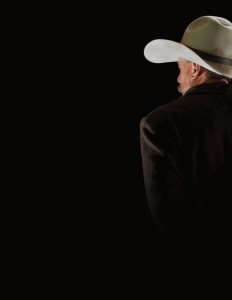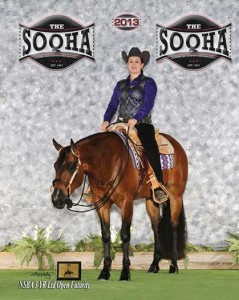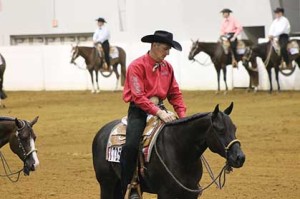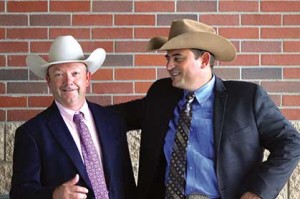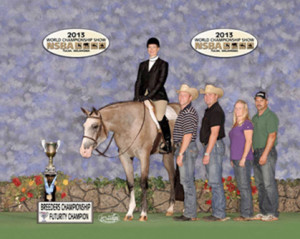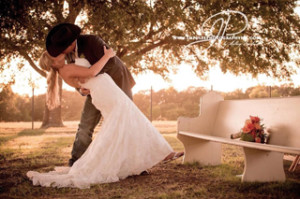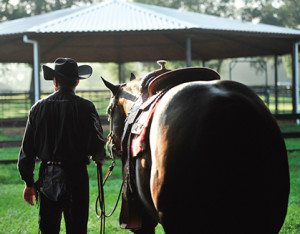Sharing Knowledge Between Generations – Part 2
Click here to read the complete article
226 – November/December, 2014
By Kristen Spinning
The Young Guns
Last month, we gained some insight into what veteran horse professionals find to be the most important aspects of being a successful horse trainer. Dedicated to passing this knowledge forward, they make it a daily practice to help, share, coach, critique, and comfort the younger trainers following in their path.
But what does the younger generation think of all this great advice? Kids never want to listen to their parents, but do young trainers want to listen to the sages of their profession?
To find out how well wisdom translates to the next generation, we asked several young professionals whose careers in the horse industry have been on a steady upward trajectory. Most of them grew up showing as youth competitors or by helping their parents who were in the horse business. They benefited from immersion education. Although they haven’t logged quite as many hours in the saddle as their older counterparts, they certainly have valuable life experience to share.
This younger generation of horse trainers has seen a rate of growth and change in the world of horse showing that parallels their own development. Everything about the business has evolved remarkably over the past 30 years. From breeding, to movement, to science, everything involving horses has moved forward at an astonishing pace. Even the practical aspects of showing and selling horses have morphed in an age of instant communication. Yet, every trainer we spoke with has a great reverence for the past, and they hold the knowledge they learned from the mentors in their lives to be most sacred.
Each young trainer promotes the values passed on by the older generation: hard work, honesty, personal responsibility, and dedication to their clients. Those core values are what make a young trainer successful in this highly competitive field. They do the hard work because they truly love the horses. Though they learned from the past, they are by no means stuck there. These breakout stars are confident in their own abilities and methods. They are propelling the horse industry forward one stride at a time.
Amanda Ringer – Somerville, TN
Though Amanda Ringer is a young horse trainer, she is by no means a newcomer to the horse industry. She has been showing since she was 10 years old. She recalls, “I’m fortunate that my parents supported me. I had good horses to ride, and they hauled me all across the country to shows.” Even as a young girl, Ringer knew she would become a trainer, and her youth and amateur success paved the way for that career path. In 2007, she was the APHA 19-44 Amateur year-end Champion with Dunthat Benthere. That year, the duo also repeated their 2006 Reserve World Champion title in Showmanship. In 2011, she picked up Pinto World Champion titles in both 2-Year-Od Western Pleasure and Senior Hunter Under Saddle.
Regarding her transition to the professional ranks, she says, “when it was time to grow up and get a real job, my parents supported me in deciding to pursue this lifestyle.”
Currently, she has her dream job. She is a trainer and manager at Masterson Farms in Tennessee. Ken and Marilyn Masterson stand RL Best of Sudden and Zippos Sheik, as well as show an excellent string of their own get. “We’ve sold most of the show horses that were ready for this year, so I’m down to just showing one currently,” she says. “I’m really pleased with how well our 4-year-old, KM Best N Sheik, is doing. He’s leading the nation in the NSBA Green Western Pleasure and not far behind in AQHA.”
What do you wish you knew when you were just starting out?
Ringer: “I knew I didn’t know everything when I started out as a trainer, and I still don’t expect to know it all. It’s important to stay open minded all the way through this journey. Don’t be afraid to learn something new or to ask people for advice. I like listening to everyone; then I pick and choose what works for me. I’ve had so many great mentors. Several of them instilled in me the lesson that you cannot overdo it with these young horses. You might only work one for 15 minutes, but if it’s a good 15 minutes, you have to know that it’s time to put them up and ride another. Another horse might take longer. No matter what, you want your ride to be productive.”
What wisdom can you share with either the younger or older generations of horse trainers?
Ringer: “This is an extremely hard lifestyle; it’s not a 9 to 5 job. You have to know if it works for you. Have something else you can do if it isn’t right for you. I would have to say, to younger trainers, don’t get frustrated if you don’t get great horses right away. You have to put in the time and work your way up. If you work hard, you will get noticed and start getting better horses and better opportunities. When I was asked to come to Masterson Farms three years ago, it was the right thing for me at the time. I was starting to expand and wanted to ride futurity horses. The Mastersons have been great to me, and I have the opportunity to ride fantastic stock. It was the right thing for me, but not necessarily for everyone. You have to do what works for you.”
What do you see as some of the most radical changes over the past 30 years?
Ringer: “The horses themselves have changed. We ask so much of them at an early age. I often wonder how we could ask any more of them or how they could get any better. I do believe breeding has a lot to do with it. There are better and better studs out there, along with really great mares. We are breeding for better-legged horses, and that has been a positive change. I think there are fewer trainers in general now, but the ones we have keep excelling in their abilities. Overall, we are so much nicer to the horses than we were 20 years ago. To me, Western Pleasure remains the main staple, and it keeps growing and growing. The horses get so well-broke that they go on to be great all-around competitors. I think we’re going in the right direction.”
What are your views on some of the latest trends in horse showing?
Ringer: “For the open Western Pleasure classes, I’m a fan of less is more in the show ring. At most of our shows, I wear button-up shirts, and I’m very happy to see that style has come back. It seems like it will be sticking around for a bit as well. At a larger show, though, I like to wear a vest to dress it up a bit. I think classes should be judged on the horse, not on what the rider is wearing.”
Gil Gaylean – Purcell, OK
Gil Gaylean laughed at the notion that he was one of the “younger generation of horse trainers” being interviewed for this series. “I feel more like I’m in the middle,” he jokes. That might be because he has been at it a long time. Galyean grew up in the business; very early on he was packed around to shows with his dad, Kenneth, a successful, professional horse trainer in his own right. It was a natural progression for Galyean to take up the training mantle, and the multiple World Championship titles he has earned are a good indication he chose the right career path.
At his facility in central Oklahoma, Galyean and his wife are busy with about 30 head in training at any one time. His program specializes in 2 year-old and 3 year-old Western Pleasure futurity horses. When he isn’t working on the rail, he rides cutting horses. “We focus on going to the major Western Pleasure futurities. I’ve got several horses that are real competitive right now; it’s hard to single out just one or two.” This NSBA Hall of Fame Rider is still a pretty humble guy who knows that it’s the dedication he exhibits, and not trophies, that keeps the clients coming.
What do you wish you knew when you were just starting out?
Galyean: “I could have been a better trainer in the beginning. It takes a long time to truly develop the skills to be a good all-around horseman. I always try to take care of my customers so they get the most enjoyment out of riding and from their horses. For the owner, it has to be fun. You can never lose sight of that. For us, it’s our livelihood, but for the client, this is their recreational income dollars they’re spending. There is a lot of other ways they can spend it. That’s not to say I didn’t know that starting out. Rather, every new trainer has to have the understanding that making sure your client is having a good time is the number one thing.”
What wisdom can you share with either the younger or older generations of horse trainers?
Galyean: “I don’t think it is so much a younger generation learning from the older thing, but you never stop learning from other trainers at any time. I always tried to observe, to study, and to learn from other successful trainers. I watch what they’re doing and how their horse is moving. I see what works and how to use it with my own horses.”
What do you see as some of the most radical changes over the past 30 years?
Galyean: “The business isn’t what it was 30 years ago. The competition is tougher. Numbers-wise, there might not be as many trainers in Western Pleasure these days, but I think the ones out there are so much more competitive. The horses, overall, are great. I wish, as an industry, we had a more closely aligned opinion of what makes a good Western Pleasure horse. Right now, there is a wide diversity of opinions on what makes an excellent mover. You see it in the judging. The top five on one card may be five that were left on the rail by another judge. Thirty years ago, I think people’s views were more consistent.”
What are your views on some of the latest trends in showing?
Galyean: “I don’t see anything real negative going on in horse showing or the industry. A lot more people are looking for a solid all-around horse. They want to be able to do Western Riding, Trail and such. Western Pleasure is kind of the supply line for those other events. Breeders are shooting for that really good pleasure horse, but it’s not closing the door on producing the all-around horse. It does just the opposite. It creates better all-around horses, and the market has grown larger for them. It has been very positive for the industry that we have such capable pleasure horses that can go on to do more. It happens that the pleasure horses I really like, for how they move and how they feel, garner a lot of interest from the all-around rider.”
Cody Copeland – Ocala, FL
Cody Copeland is another young trainer who was initiated into the game as a kid because it was the family pastime. Cody, his brother, and his sister started in 4-H and then moved on to AQHYA competition. Copeland then found success as a young amateur, and there was no stopping him. Today, along with his wife, Melissa, Copeland Show Horses specializes in the fitting of world-class halter horses for AQHA, PHBA, and APHA. He has a loyal clientele of amateur and youth exhibitors. Cody helps guide the careers of such greats as the 3 year-old gelding Westexascowboy and AQHA stallion Cajun Acquisitions.
What do you wish you knew when you were just starting out?
Copeland: “I wish I had a better business background and the skills to manage money better. There’s a lot more to it than just being a good horseman. It’s a business.
“I got my start from Ross Roark, though, I have to say. I learned a lot from a lot of people. Ross has an amazing work ethic. He taught me; if you want it, work for it. Do your work at home and make sure you’re ready when you go into that ring.”
What wisdom can you share with either younger or older generations of horse trainers?
Copeland: “When I was a youth exhibitor, I asked Jerry Wells for pointers. He said something that has stuck with me all these years: ‘If we don’t take care of our youth, we don’t have a future.’ I guess that’s something we all need to be reminded of from time to time.”
What do you see as some of the most radical changes over the past 30 years?
Copeland: “Back in the ‘90s, everyone wanted a posty, hot horse. We have gotten away from that now. Legs and hocks are important; conformation is important. Breeding has changed over the years, and that’s a good thing. We were producing way too many bad-legged horses. The big money futurities are emphasizing a solid foundation, and that’s getting the legs, feet, and conformation back to where they need to be.”
What are your views on some of the latest trends in showing?
Copeland: “The halter horse business is still tough right now. Not everybody can afford to buy and fit a new horse every year. A lot of people want a return on their investment with horses, so you see the trend of more and bigger futurities. They want the chance to win some money. The Breeders Halter Futurity has become very popular. I think, because of that, we’ve seen an increase in people looking for weanlings and yearlings. Hopefully, it’s a sustainable trend, and people will continue to sponsor it. We have also seen that Performance Halter is coming on strong.”
“Another good trend is that, in AQHA, you can qualify easier. Shows that have six judges are a big help, too. As much as it costs to show anymore, it’s great that an amateur can qualify in one weekend.”
Sara Simons – Pilot Point, TX
Multiple World Champion Sara Simons is more enthusiastic about the horses she has the privilege to train and ride than the trophies they win. Her stellar roster has included Sensational Blonde, InTheSweetShop, Ms Silver Sensation, and Radicalized. One of her most notable and history making accomplishments was to pilot Taylor Prince’s One Flashy Sensation to clinch APHA World Championships in the 2-Year-Old, 3-Year-Old, Junior, and Senior Western Pleasure. The trio has continued to pick up awards in Trail, Western Riding, Horsemanship, Showmanship, Hunt Seat Equitation, and Hunter Under Saddle, proving the mare’s all-around capabilities. It’s no wonder Simons has all the right moves. As the daughter of judge, clinician, and breeder, Andrea Simons, and the late Paint industry icon, Lynn Simons, Sara Simons had horse training in her DNA and the perfect environment at Simons Show Horses in which to perfect her skills. Along with her success in training, Simons’ career is expanding as an APHA, NRHA, and NSBA judge as well as maintaining a busy schedule as a clinician.
Focusing on youth and non-pro all around riders is her passion. “I have the good fortune of having a number of horses with a really good foundation in Western Pleasure. That helps me to build them into great all-around horses.” Currently, she and her boyfriend, RJ King, work and train together.
What do you wish you knew when you were just starting out?
Simons: “You can never really rest in this business. Being located in Texas, there is no down time or off-season. We’re going all year long. You have to remember that you are only as good as your last class. If you take a break, and someone else doesn’t, they will keep going ahead of you. It’s important to know, when you’re first starting out, you have to be accountable for everything you do. RJ and I do all the work together, and that means everything. It’s our responsibility. We don’t delegate; we just get it done. Maybe when I’m older I’ll delegate better.”
What wisdom can you share with either younger or older generations of trainers?
Simons: “My mom and dad had an amazing work ethic that they passed on to me. Between them and the other incredible horsemen I was always around while growing up, I learned compassion, responsibility, and the foundation of true horsemanship. It’s important you do this because you love the horses and not for the glamour or the prizes. There’s so much more to the business than that. I love doing the breeding, messing with the babies, and watching them grow up. It’s the full cycle. It’s also important to make sure your clients are having an enjoyable experience.”
What do you see as some of the most radical changes over the past 30 years?
Simons: “The quality and level of the horses is exceptional now. You need a really excellent Western Pleasure horse to do Western Riding or Trail. It has to be a great mover in all the classes. A strong Western Pleasure background gives the horse a complete foundation to excel in the other classes. It costs a lot to go to a show, so amateurs want more chances in the ring. They want to do all-around now, and that’s driving the need for horses to be able to do more, and to do it better. To be successful as an all-around candidate, the horse also has to have a good mind and natural ability. It takes a lot of effort to compete in several classes.”
What are your views on some of the latest trends in showing?
Simons: “Hunt Seat Equitation horses are more pushed forward. They move more like a true Hunter. That’s really nice to see.”
Tate Oakley – Collinsville, TX
As the son of trainer, Troy Oakley, Tate Oakley grew up surrounded by many great horsemen. He had the good sense to listen, watch, learn, and absorb everything he could from them. It was a successful strategy that propelled him to win an AQHYA Western Pleasure World Championship in 2002 on his sorrel mare, Vested Faith. From that point on, his future was engraved in silver. Oakley has since earned multiple Congress, NSBA, and AQHA World Championships, and has garnered the admiration of his early mentors.
Success in the arena is nice, but Oakley says his most meaningful accomplishment was marrying his wife Jamie in September. “There’s never a great time to get married in the horse business,” he quips. “Somehow, we managed to pick a time when most of our friends and family could make it.” Jamie has been a big part of Oakley’s training and showing success. She also competes in all-around events. “Jamie is so important to me, and she helps me so much. She’s my eye on the ground as well as my support system. I couldn’t do it without her.” The Oakleys may certainly be a powerhouse team in the years to come.
What do you wish you knew when you were just starting out?
Oakley: “Horse training has been in my blood. This business is not for the weak hearted, that’s for sure. When I made the decision to become a professional trainer, I knew it would be difficult, but I never thought that anything I came across was going to surprise me.
“I learned so much from Rusty Green, Butch and Patty Campbell, and others. I learned about horses, but more than that, I learned a lot about myself. Butch emphasized the importance of people skills and how you always have to put your client first. You have to be able to deal with all types of people and do it well under pressure. If a horse gets hurt, you have to know how to handle that and know what to say to the worried owner. Your clients are putting their faith in you, so you are there for them 24 hours a day, 365 days a year. Right from the start, it’s important to understand that it doesn’t matter if a client’s horse cost $1,000 or $200,000; the same amount of care and effort goes into each one. Just because an owner can’t afford to go to all the shows, that doesn’t mean you should pass them by. When you take the time and compassion with those folks, you find they can be the most rewarding relationships. They can be the most down to earth people you’ll ever meet.”
What wisdom can you share with either the younger or older generations of horse trainers?
Oakley: “Above all, you need people skills. If you don’t have that, it doesn’t matter how good you are in the saddle or how great your horses are, you won’t make it. I would say to anyone getting started in this business, don’t get caught up in the glitz and glamour. When you are earning some money, set something back. Everyone wants the fancy trailer, the new truck, all the latest tack, and the saddle with all the silver. I’m guilty of that, too. But I make sure I buy stuff that will last me a long time. You have to learn how to save. When you are going to spend money, be sure you spend it on the tools that are going to help you make your living.
“I also want to stress that trainers need to have health insurance. I’ve had even the calmest horse break in half and try to buck me off. They’ll spook. Things happen. You never know when it’s going to happen. If you get hurt, you need health insurance. Your body, your hands, your feet, and your mind are what you need to make your living. With out them, you’re stuck. What are you going to do then? You have to take care of yourself.”
What do you see as some of the most radical changes over the past 30 years?
Oakley: “The biggest change definitely has to be in movement. The advances we’ve seen in all of the events are incredible. It’s not just in Western Pleasure. Look at the reiners or the cutters and what they are doing these days. It used to be with the cutters, their heads were high and they just flipped from side to side. Now, their heads are low, they are getting down, and doing these radical moves. The reiners are so specialized now. When you look at how they are moving and the position of their bodies when they stop or spin, it’s fantastic. Our ability to precisely control that movement has come a long way over the years. It’s a change for the better, I think.
“Overall, I think we are headed in the right direction. NSBA is doing a great job of getting people to understand what is going on in the industry and trying to get everyone on the same page. AQHA is doing the same. A big factor for our industry is the economy. We change with the economy. As trainers, it may be our livelihood, but for most of our clients, it’s their recreation. Now, it looks like the economy is coming back some and people have more money to spend, so hopefully that will be good for the horse business.”
What are your views on some of the latest trends in showing?
Oakley: “I don’t pay attention to trends. I’m more of a march-to-the-beat-of-my-own-drum person. I’m not big on imitating. I ride what I feel beneath me. If I think something needs to be fixed, I change it. Now, if you see something someone is doing that you like, or looks interesting, ask the person. Like with Rusty Green or Gil Galyean, if I see them doing something or they’re getting a result with some technique, I’ll go up and talk to them and get them to show me. Then, I’ll go home and try it. But not everything works the same for everybody. Every horse is an individual, so it may not suit you. Don’t get caught up in mimicking (other trainers) just because someone else is doing it.”
Wade Parks – Colbert, GA
Wade and his wife, Carly, own and operate Parks Show Horses, specializing in Western Pleasure and all-around AQHA and APHA horses. Both accomplished riders, the pair have edged each other out of first place in many line-ups. At the age of 29, Parks has seen a swift rise to the top. “I’m really just a country boy from West Virginia,” he says humbly. He truly started out at the bottom and had to bootstrap himself up through hard work. “When I went out on my own, at the age of 22, I had to go get myself a work saddle and a couple of horses,” he says. “I owe a lot to other trainers who helped me starting out. Ty and Karen Hornick were a big influence on me. Also, Kenny Lakins would give me horses to go ride. That helped out a ton.”
People took notice of his talent and good old-fashioned work ethic. Wade doesn’t have to scratch around looking for a saddle anymore. Folks bring him top horses. He speaks his mind and sticks to his guns; it’s a trait valued by his peers. Recently, Wade has been seen scooping up titles aboard the flashy Sensational Design and has also guided the career of the overo stallion, Lopin Lazy.
What do you wish you knew when you were just starting out?
Parks: “I probably should have kept my mouth shut more. You can’t guarantee anything in this business. Being a horse trainer is a job. You get up each morning and go to work like any other job. I wouldn’t do this if I didn’t love horses.”
What wisdom can you share with either the younger or older generations of horse trainers?
Parks: “You always have to be up front and respectful with clients and all the people you work with. Be fair, be honest, and don’t be lazy. Do your job well, and people will send you horses. So often, I hear younger trainers saying, ‘that horse doesn’t fit my program.’ That’s quite an attitude. I know what fits my style as a rider and trainer; I know what I like. But horses are individuals, and you have to be able to work with their needs rather than pass them off as not fitting with your program.”
What do you see as some of the most radical changes over the past 30 years?
Parks: “People used to get their start working for someone else by taking the time and really learning the business. It’s hard to find an assistant trainer these days. Everyone wants the glory right away. They want to be out on their own and expect they’ll get the best horses. Some get lucky and do it. At the same time, though, there aren’t as many young trainers coming up in the business as there were 20 or 30 years ago. There aren’t as many horses either.”
What are your views on some of the latest trends in showing?
Parks: “The pleasure horses look better now than ever, and the all-around horses are getting better, too. I see a trend in judging, however, where the riders who may not be the most sleek and slender gals are not getting as good of scores, even though they ride just as well or better. That’s not fair. They are spending the same amount of money as everyone else, and they should be judged the same way.
“Also, I really don’t like the trend of designed hats in Western Pleasure. I’m more of a classic person; I like a simple, clean look in the arena.”
Josh Robertson – Reddick, FL
Josh Robertson is a second-generation Western Pleasure and All-Around horseman. He started showing around the age of twelve and found success early and often. Robertson has trained and shown Congress and AQHA World Champions as well as champions at all the major Western Pleasure futurities in the United States.
Today, Robertson and his wife are the trainers at Olivia Hoecker’s Pine Meadow Quarter Horses, one of the top Western Pleasure breeding and showing operations in the country. Pine Meadow is home to Congress and AQHA World Champion sires Hotroddin Zippo and Mr Notibily Zippo among others. Robertson loves the facilities and the opportunities he has there. “We also accept a limited number of outside horses; it’s a great situation for everyone involved.” When asked what he has been up to lately, he jokes, “I live in Florida and sit on the beach!” In reality, the only sitting around this exceptionally busy young trainer does is in the saddle, and those saddles have been carrying Robertson and his ubiquitous smile to center ring to pick up trophies and plenty of cash.
This year, he’s had the pleasure of showing a stallion named Hez Plum Poison in Jr. Western Pleasure. He’s qualified for the AQHA World Show in both Western Pleasure and Performance Halter Stallions. At the Little Futurity this year, the pair won the $2,500, $5,000, and $10,000 Limited horse classes, and Hez Plum Poison is currently the High Point leader in AQHA Jr. Western Pleasure. Robertson will also be showing at the AQHA World Show in Sr. Western Pleasure on Miss Hotroddin Pine and in 2 Year-Old Western Pleasure on Ms RL Flashy Goodbar.
What do you wish you knew when you were just starting out?
Robertson: “The customers are the ones who pay the bills. It’s not like I didn’t know it; I just didn’t think about it as much as I should have. They give us the opportunity to do what we love. It’s important we do well with their horses, but it’s equally important that they enjoy their time at the shows. This is supposed to be fun for them.
“There is nothing easy about this business. If you don’t have a true love for it, find another profession, but if you do, embrace it. Believe in yourself and your ability. If you don’t, no one else will! There are so few young people coming up, and I understand why, but I think it’s unfortunate at the same time. We need more people with the love of the horses that some of us have. The horses are not just vehicles to success; they are friends and partners in success. I have been so fortunate to work with some great horseman that taught me about being a real horseman. I think that has been lost along the way in our industry; true horsemen are few and far between.”
What wisdom can you share with either the younger or older generations of horse trainers?
Robertson: “I don’t know if I’m part of the younger or older generation of trainers, but I do know there isn’t much of a younger generation, and that should say something to all of us. Have we taken care of our business over the years? I know I’m supposed to be answering the questions, but I find myself asking that question often. How did we get here and why? I wish we had those answers, and I would love to have them. My daughter, Adaleigh, just turned two. I hope, if she wants to be a trainer some day, she can!”
What do you see as some of the most radical changes over the past 30 years?
Robertson: “Radical changes? Have you watched our pleasure horses lately? I started showing when I was twelve years old; they don’t even resemble the horses we showed then. I’m not saying the horses or riders were better back then, but the flow and rhythm of our pleasure horses has certainly changed.”
What are your views on some of the latest trends in showing?
Robertson: “Trends are changing quickly. I believe the horses are starting to get some flow and rhythm back. I see our next big challenge as being the off front leg at the lope. Many of our pleasure horses are bringing the off front leg forward to the point it’s almost even with the inside front leg. I hear people saying, ‘but it’s got a big hock.’ If its front stride and back stride don’t match up, that’s not pretty to me! I think some people just think that it’s normal anymore, but it’s not!”










